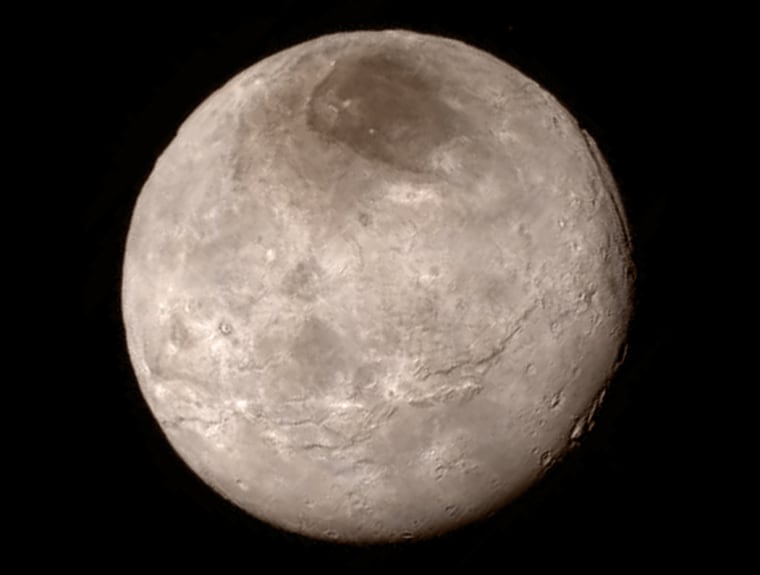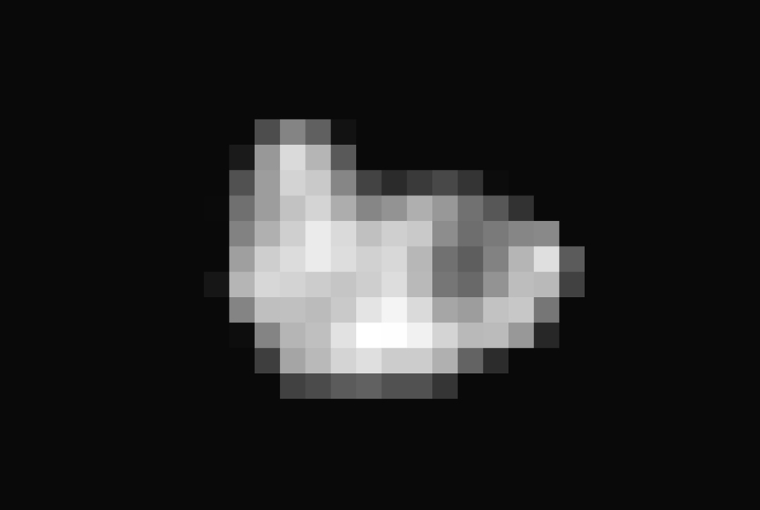LAUREL, Md. — Scientists say the first pictures sent back by NASA's New Horizons probe after this week's unprecedented Pluto flyby reveal towering mountains made of frozen water — and a giant dark impact basin on top of its biggest moon, Charon.
The leaders of the New Horizons science team say even they are flummoxed by the images from an icy, alien realm on the edge of the solar system, 3 billion miles (5 billion kilometers) away.
"Who'd have supposed that there are ice mountains?" Johns Hopkins University's Hal Weaver, project scientist for the New Horizons mission, said Wednesday during a news briefing here at JHU's Applied Physics Laboratory.
Principal investigator Alan Stern of the Southwest Research Institute called the findings "balloon-busting."
Related: 5 Things We Just Found Out About Pluto and Charon
The images were received overnight and analyzed by the science team at the Applied Physics Laboratory, just hours after the piano-sized New Horizons spacecraft sped past Pluto and its moons at more than 30,000 miles (50,000 kilometers) per hour. The probe came within 7,750 miles (12,500 kilometers) of Pluto's surface, snapping pictures and taking data throughout the encounter. Mission managers said the spacecraft was in good health, and loaded up with so much data that it will take 16 months to download it all.
This first delivery was an auspicious one: The Pluto image showed a small region near the southern end of the dwarf planet's bright, heart-shaped region in 10 times greater detail than previously available. John Spencer, a member of the New Horizons team from the Southwest Research Institute, said the "heart" has been informally named Tombaugh Regio — after Clyde Tombaugh, the American astronomer who discovered Pluto in 1930.
The image showed jagged mountains rising as high as 11,000 feet (3,500 meters) from the surrounding terrain. Even though Pluto is covered with frozen nitrogen and methane, those substances aren't strong enough to build mountains that high, Stern said.
"The bedrock that makes those mountains must be made of H2O, water ice," Stern said. "We see water ice on Pluto for the first time. We can be very sure that the water is there in great abundance."
What's more, the mountainous terrain shown in the image must have been created no more than 100 million years ago — otherwise it would show evidence of more impacts, scientists said. "This is one of the youngest surfaces we’ve ever seen in the solar system," Jeff Moore, a member of New Horizons' geology, geophysics and imaging team, said in a NASA news release.
The mission's scientists don't know what process created the mountains, but they're sure it's not tidal heating — which drives geological activity on, say, Jupiter's moon Io. They speculated that radioactive elements embedded in Pluto's mix of rock and ice may be generating enough heat to make Pluto geologically active. "This may cause us to rethink what powers geological activity on many other icy worlds," Spencer said.
The New Horizons team can't yet say whether Pluto has a subsurface reservoir of liquid water — but the results revealed Wednesday certainly don't rule that out.

Related: Neil deGrasse Tyson: New Horizons Is a 'Triumph'
Nine and a half years after its launch, New Horizons is providing the first detailed look at a world on the solar system's farthest frontier. Before the mission, the best pictures of Pluto were fuzzy images captured by the Hubble Space Telescope. Now the world is getting to know Pluto and its moons as worlds unlike any other.
Another image released Wednesday shows Pluto's moon, Charon, in unprecedented detail. "Charon just blew our socks off," said the mission's deputy project scientist, Cathy Olkin of the Southwest Research Institute.
Olkin said Charon's north pole is dominated by a gigantic impact basin, which has been nicknamed Mordor to pay tribute to the dark land in J.R.R. Tolkien's "Lord of the Rings" trilogy. The picture also shows linear features and troughs circling Charon's surface — including a canyon that's 4 to 6 miles (7 to 10 kilometers) deep.
The image doesn't show as many craters as scientists expected, which suggests that the surface is geologically young and still active, Olkin said.

Related: Stephen Hawking Explains the Meaning of New Horizons
Another newly released image shows Hydra, one of Pluto's small, irregularly shaped moons. Hydra was discovered in 2005 during the preparations for New Horizons' launch, and the highly pixelated view seen Wednesday's picture is by far the best view ever captured.
Scientists said Hydra is about 27 miles by 20 miles (43 by 33 kilometers), and they were able to determine its composition by analyzing its brightness, mass and dimensions.
"Hydra's surface is probably composed primarily of water ice, and that's cool," Weaver said.
The images unveiled on Wednesday are only the start. Even though New Horizons is now speeding away from Pluto and its moons at tens of thousands of miles per hour, it has saved up billions of bytes worth of data on its solid-state recorders, and will continue to send the signals back at a rate of 1,000 to 2,000 bytes per second — from a distance so vast that it takes 4.5 hours to reach Earth at the speed of light.
After all those pictures and data are sent back, the $728 million New Horizons mission could be extended to accommodate another flyby past an even more distant object in the Kuiper Belt, the region of icy objects beyond the orbit of Neptune. But for now, Stern and his colleagues are enjoying the first flush of discovery.
"I don't think anyone of us could have imagined it would be this good of a toy store," Stern said.
"This is what we came for," Will Grundy, a member of the science team from Lowell Observatory, said in reply.
"This exceeds what we came for," Olkin added.

